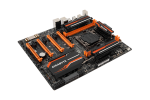11. Metodologia di prova
Configurazione
Per testare le prestazioni della GIGABYTE GA-X99-SOC Champion abbiamo completato la nostra configurazione con i componenti elencati nella tabella sottostante.
| |
| Processore | Intel Core i7-5930K |
| Memorie | Corsair Dominator Platinum 3400MHz 16GB C16 |
| Scheda Video | MSI N780 Lightning |
| Alimentatore | Seasonic X-1250W |
| Unità di storage | Plextor M6 Pro 256GB e Plextor M6e M.2 256GB |
| Raffreddamento | Impianto a liquido su Banchetto Microcool 101 |
I test sono stati svolti con due distinte frequenze della CPU:
- 3500MHz Turbo Boost ON (Max 3700MHz) - RAM 2666MHz (15-15-15-35)
- 4471MHz Turbo Boost Disattivato - RAM 3400MHz (16-18-18-36)
Tutte le prove sono state eseguite con il Command Rate delle memorie impostato a 1.
| | |
| | |
| Core i7-5930K @ 3500MHz - Turbo Boost ON |
| | |
| | |
| Core i7-5930K @ 4471MHz - Turbo Boost OFF |
Il sistema operativo scelto per questa recensione è Microsoft Windows 8.1 Professional aggiornato alla versione Update 1 e con gli ultimi INF Driver di Intel.
Al fine di verificare la bontà della nuova piattaforma, i risultati dei benchmark effettuati sui controller SATA III ed M.2 sono stati comparati con quelli ottenuti nelle medesime condizioni su una piattaforma Z97 costituita da una scheda madre MSI Z97 XPOWER AC e CPU Intel Core i7-4770K.
Di seguito l'elenco dei software utilizzati per le nostre prove.
Compressione e Rendering
- 7-Zip 64 bit
- WinRAR 64 bit
- MAXON Cinebench R15 64 bit
- POV-Ray v.3.7 Beta 38 64 bit
Sintetici
- Futuremark PCMark 8 64 bit
- PassMark Performance Test 8.0 64 bit
- Super PI Mod 1M 32 bit
- AIDA64 Extreme Edition
Grafica 3D
- Futuremark 3DMark 2013
- Futuremark 3DMark 11
- Unigine Heaven Benchmark 4.0
SSD & USB 3.0
- IOMeter 2008.06.18 RC2
- CrystalDiskMark 3.0.3 x64
Videogiochi
- Crysis 3 - DirectX 11 - FXAA - Qualità Massima
- Battlefield 4 - DirectX 11 - AA4x - Qualità Ultra
- Tomb Raider - DirectX 11 - Qualità Estrema









